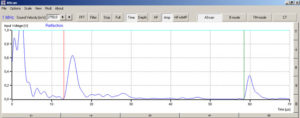PHY06 Frequency Dependence of Resolution
Couldn't load pickup availability
Frequency Dependence of Resolution
Investigation of the axial resolution of two ultrasonic probes of different frequencies using two small and closely spaced defects
Examination methods using ultrasound systems are based on the exact assignment of information from a point in the examination area to a recorded ultrasound echo. Consequently, the resolution of the ultrasound probes is extremely important. The resolution can be described as the smallest possible distance between two points whose echoes the probes can still detect separately. In the experiment, two neighboring faults in a test body are to be examined with a 1 MHz probe and a 4 MHz probe. The size, position and distance of the faults are selected so that differentiation is only possible with one of the two examination probes. In this way, the influence of frequency on the axial resolution of an ultrasound probe can be clearly shown.
In the experiment, a slightly attenuated echo is first searched for with each of the two ultrasound probes and the frequency, wavelength and pulse length are determined. The double disturbance of the test body is then examined. The screenshots of the measurement software show recorded A-scans of the double disturbance (top 1 MHz, bottom 4 MHz). In addition to the higher resolution of the 4 MHz probe, the stronger attenuation of the 4 MHz signal is also clear. In comparison to the 1 MHz probe, the ground echo is almost no longer visible with the 4 MHz probe.

A-Scan with 4 MHz probe
SCOPE OF DELIVERY:
| Item No. | Designation |
|---|---|
| 10400 | Ultrasonic echoscope GS200 |
| 10151 | Ultrasonic probe 1 MHz |
| 10154 | Ultrasonic probe 4 MHz |
| 10201 | Test block (transparent) |
| 10204 | – optional: test block (black) |
| 70200 |
ADDITIONAL EXPERIMENTS:
| PHY08 | Ultrasound B-scan |
| IND01 | Non-destructive testing (NDT) |
| MED02 | Ultrasound examinations on the breast model (mammography) |




